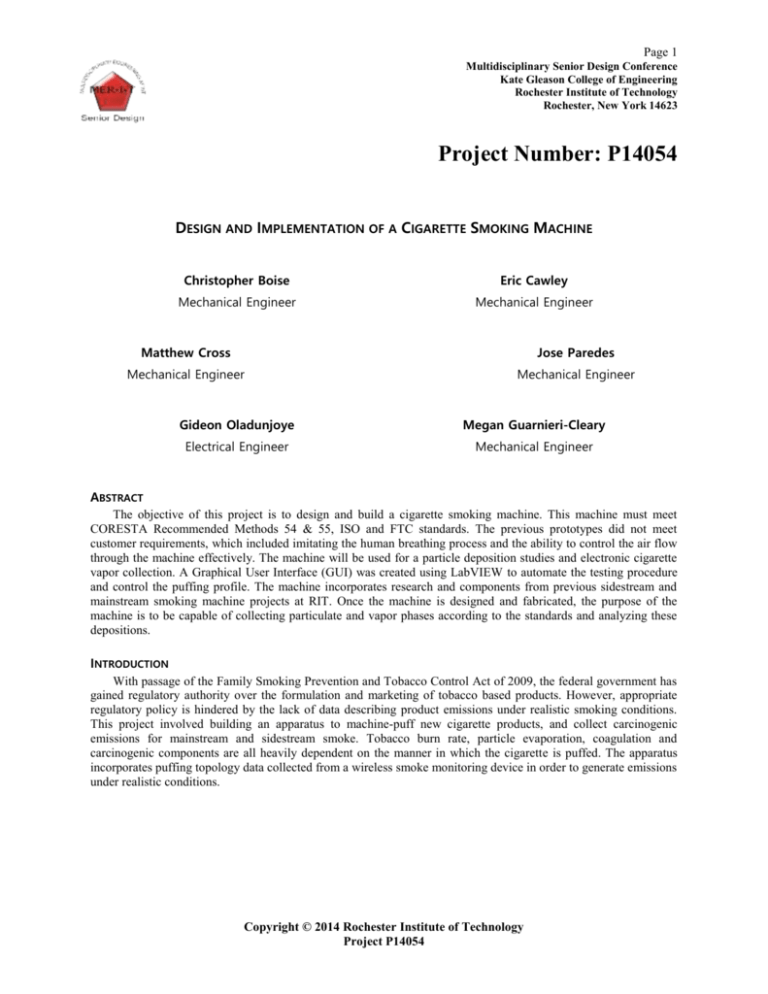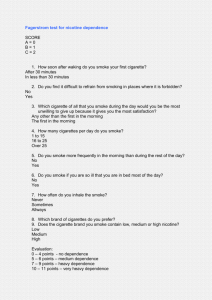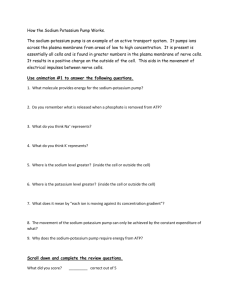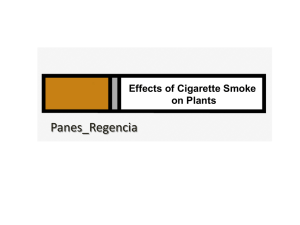Technical Paper - EDGE - Rochester Institute of Technology
advertisement

Page 1 Multidisciplinary Senior Design Conference Kate Gleason College of Engineering Rochester Institute of Technology Rochester, New York 14623 Project Number: P14054 DESIGN AND IMPLEMENTATION OF A CIGARETTE SMOKING MACHINE Christopher Boise Eric Cawley Mechanical Engineer Mechanical Engineer Matthew Cross Jose Paredes Mechanical Engineer Mechanical Engineer Gideon Oladunjoye Megan Guarnieri-Cleary Electrical Engineer Mechanical Engineer ABSTRACT The objective of this project is to design and build a cigarette smoking machine. This machine must meet CORESTA Recommended Methods 54 & 55, ISO and FTC standards. The previous prototypes did not meet customer requirements, which included imitating the human breathing process and the ability to control the air flow through the machine effectively. The machine will be used for a particle deposition studies and electronic cigarette vapor collection. A Graphical User Interface (GUI) was created using LabVIEW to automate the testing procedure and control the puffing profile. The machine incorporates research and components from previous sidestream and mainstream smoking machine projects at RIT. Once the machine is designed and fabricated, the purpose of the machine is to be capable of collecting particulate and vapor phases according to the standards and analyzing these depositions. INTRODUCTION With passage of the Family Smoking Prevention and Tobacco Control Act of 2009, the federal government has gained regulatory authority over the formulation and marketing of tobacco based products. However, appropriate regulatory policy is hindered by the lack of data describing product emissions under realistic smoking conditions. This project involved building an apparatus to machine-puff new cigarette products, and collect carcinogenic emissions for mainstream and sidestream smoke. Tobacco burn rate, particle evaporation, coagulation and carcinogenic components are all heavily dependent on the manner in which the cigarette is puffed. The apparatus incorporates puffing topology data collected from a wireless smoke monitoring device in order to generate emissions under realistic conditions. Copyright © 2014 Rochester Institute of Technology Project P14054 Page 2 PROCESS Requirements The customer requirements were found from the initial project readiness package, the CORESTA & ISO standards and customer-team meetings along the design process. The project readiness package gave some initial lab constraints for the design as far as size and which particular tools the design must utilize. The concept development of the sidestream system is based off of the CORESTA 54 & 55 standards. CORESTA details a basic design based on collecting the particulate and vapor phase of the side stream smoke. Figure 1: CORESTA 54 system According to ISOs 3308, 3402, 4387, 6565, 7210, and 20774 the cigarette needs to be held level with a maximum droop of 5 degrees from the horizontal axis. The ashtray needs to be 20-60 mm below the cigarette’s axis. Pressure drop of the mainstream flow path shall not exceed 300 Pa at a test flow rate of 17.5 ml/s. Filter system pressure prop should not exceed than 250 Pa. Dead volume should not exceed 100 ml. Labyrinth seals shall be used for attaching cigarettes. Cigarettes should be lit with an ignition coil on the first try. Fishtail chimney shall be 6 mm from horizontal plate. Sidestream smoke should be drawn at a constant 3 SLPM. System Design In order to realistically replicate cigarette puffs our group decided to implement a syringe pump. This replaced the valve regulated centrifugal pump from previous mainstream teams. The syringe pump interfaces with LabVIEW which sends the proper commands from the puffing profile spreadsheet. Another important aspect to this project was to not only combine previous mainstream and sidestream projects but to do so in a spatially efficient manner. To do this a 2 ft by 3 ft Rubbermaid cart was selected to constrain the project. A 22 inch tall chamber was constructed to enclose residual smoke and provide a controlled testing environment. One side of the chamber sides was designed to lift up completely to provide easy access to filters and cigarette holder. A smaller quick access door was also fabricated. On the lower portion of the cart most electronics and and syringe pumps were mounted to free space on the upper deck. To increase test repeatability and decrease test setup time, linear actuators were used to light the cigarette and raise the fishtail chimney. This project also acquired an EcoFlo blower. This blower processes smoke not captured by system filters and provides a controlled atmosphere. The EcoFlo is comprised of two independently controlled blowers for supply air and exhaust. These are configured to provide a negative pressure chamber to prevent smoke Copyright © 2014 Rochester Institute of Technology Project P14054 Page 3 from leaking out. Ignition Coil Design Previous smoking machine projects encountered heat management problems with the ignition coil. Excess heat was melting wire insulation and possibly contaminating smoke samples. A new ignition coil was designed with a positively charged aluminum conductor and grounded coil block. The aluminum conductor plate allowed the charged wire to attached further away from the heat to prevent insulation melting. To insulate the charged conductors from the system a layer of acrylic was used. Figure 2: Ignition Coil Flow Confirmation Design Taring within the system poses a difficult challenge for flow confirmation. In order to confirm flow rates at the cigarette sensors can not be in the flow path. Static pressure sensors are used to calculate flow rate with the ideal gas law (1). Assuming the mass flow rate at the cigarette is the same at the pump, static pressure sensors can be used to calculate the cigarette flow rate (2). During the design phase temperature was determined not critical. The temperature term simply drops out of equation 2. Tcig Ppump PV = nRT (1) Q cig = Q pump ( ) ( ) (2) P T cig Copyright © 2014 Rochester Institute of Technology Project P14054 pump Page 4 Figure 3: Flow Block Diagram Particle Deposition Design A particle deposition analysis was performed to determine the percentage of particulate matter that would be lost due to the tubing. Particle deposition can occur based on sedimentation, diffusion, and impaction. Impaction only occurs when there are bends or kinks in the flow path. Since the tubing used from the cigarette to the main collection unit is straight, impaction was neglected. Some assumptions made in this analysis include incompressible flow, sea level with standard atmosphere, continuous fluid, particles are represented as spheres, constant and uniform velocity, 2-dimensional analysis, ideal flow, and constant properties. Using the non-dimensional parameters seen in equations (3) and (4) as well as the settling velocity equation (5) the particle deposition was determined for a range of particles sized up to 10 micrometers. The resulting ε and Δ were found to be 0.009 and below 4.0E-5 respectively for particles sized up to 1 micrometer, which is the standard size seen in cigarette smoke. These results indicate well below a 2% particle deposition. This indicates negligible deposition due to both sedimentation and diffusion. The figures below detail the particle deposition for a range of particle sizes. Equations: (3) (4) (5) Copyright © 2014 Rochester Institute of Technology Project P14054 Page 5 Figure 4: Particle Deposition as a Result of Sedimentation Figure 5: Particle Deposition as a Result of Diffusion Pump Selection Researching an appropriate pump provided multiple options. The main goal for the pump is to simulate a lung smoking a cigarette. Keeping that in mind, we figured a syringe pump, having discrete puffs, would be a better representation than a conventional centrifugal vacuum pump, operating under continuous pull. The syringe pump has the ability to draw and expend its volume, just like a lung. Before determining if a pump was appropriate, we needed to know the loading concerns the pump will be facing. Initial calculations and (manual) testing of the system determined the minimum force required. It was found that a force of 4.058 N or 0.91 lbf was required to operate the system. The chosen model is OEM-570 from New Era Pump Systems. This is a 'high-speed' pump compared to the corresponding models New Era offers. This pump, using a single 140 mL syringe, can produce a max. flow rate of ~45 mL/s. Conversations with the company stated this pump could be outfitted with a double syringe bracket. With a single pump, two syringes, produces ~90 mL/s max. flow. H-Bridge Selection An H-Bridge motor driver is a device used to control the operations of a motor by allowing the variability of speed, and direction. With the exception of speed, our design called for direction as a parameter. An H-bridge device Copyright © 2014 Rochester Institute of Technology Project P14054 Page 6 proved to be the simplest form of implementing this, with the most precision in the runtime of the device at a constant speed. The H-bridge specified had to supply voltages to two actuators. Each actuator required 12 Volts at 3 Amps to operate. The H-bridge specified also had an on and off switch, as to enable the component to be switched off when testing other components on the machine. As the build of the machine progressed, the value of the on/off switch was realized because it protected the device from accidental short circuiting of the device. Electrical System Design Simplicity was the methodology behind the electrical system design. To keep the system as simple as possible, components were designated to blocks which make up the system. These sub blocks are the power block, control block, pump unit, motor driver unit, and the various tools used in the machine. The power block consisted of the 12 and 15 volt sources, the power strip and the various relays used in the system. The computer and the National Instruments Data Acquisition unit (DAQ) make up the controller block. The pumps in the system are separated from the DAQ, and operate directly from the computer. The motor driver unit consists of the H-bridge motor driver, the limit switches used to prevent the actuators from ramming into other components, and the two actuators. The tools used in the system were seen as loads which required power from the power block as well as control from the DAQ through the computer. These tools are the coil lighter, valves, and sensors in the machine. Certain components such as the side stream pump were left out of the design because there implementation was a simple connection to the power strip. The final wiring schematic, created in P-spice, can be seen in figure 6. Figure 6: Cigarette Smoking Machine Schematic Diagram RESULTS AND DISCUSSION A standard test starts with a technician opening the main access door to load a cigarette, replace filers and replace impinger methanol. When the test is ready sidestream pump is switched on, chamber is closed, and the EcoFlo blower is switched on. Before the technician starts the LabVIEW program the sidestream flow rate is set to ISO standard 3 SLPM. The LabVIEW program starts and configures the solenoid valves for the initial drag. The program warms up the ignition coil and moves it in for ignition. When the coil is close the initial drag begins to light the cigarette. After the cigarette is lit, LabVIEW retracts the ignition coil and lowers the fishtail chimney to capture sidestream smoke. Once the syringe pump finishes its initial drag the program configures the solenoid valves to purge mainstream air captured in the syringes. This air is purged directly to exhaust. LabVIEW then prepares for the next puff and continues. When the test finishes, a solenoid valve cuts off the cigarette from mainstream flow and another valve opens to draw clean air. The system then drags clean air to capture any smoke left within. Once the system purge is complete, the fishtail chimney raises. After the test, the technician collects the filters and methanol from the impinger. Copyright © 2014 Rochester Institute of Technology Project P14054 Page 7 Figure 7: Top Dragging Puff Flow Figure 8: Clearing Puff Figure 9: Bottom Dragging Puff Flow Figure 10: Exhale Puff Before each test a Cambridge filter’s mass was carefully measured. A cigarette is smoked through the mainstream filter and the mass was measured again. The difference of these masses produced a measurement of the total particulate matter or TPM. Copyright © 2014 Rochester Institute of Technology Project P14054 Page 8 Figure 11: Relationship between deposition and humidity The figure above depicts the average particle deposition of mainstream cigarette smoke. Total Particulate Matter on average ranged from 1.8 mg to 2.3 mg with the low tar 1R5F research cigarettes. These cigarettes claim to deposit 2.08 mg [1] of particulate matter when smoked under a standard ISO puffing profile. P14054’s smoking machine produces results comparable to the industry standard. CONCLUSIONS AND RECOMMENDATIONS Overall this project was a success. The machine incorporates components from previous senior design teams into a smaller package and automates the process with LabVIEW and actuators. The machine also realistically smokes cigarettes with custom puffing profiles sent to the syringe pump. Particle collection on the Cambridge filters was also confirmed to produce consistent results. Variability of the results is suspected to be due to the variability in the cigarettes themselves. Quick connects and quick cramps were used in the majority of the connections in the machines. Occasionally, quick cramps will slip out, and tugging on the quick connects can break the wire. It is recommended that occasional maintenance be conducted on the machines for any loose wire, before operation. In the case that another MSD team is in the draft for this project, they can be tasked with rewiring the machine without the use of these connectors. Further development with the machine will test electronic cigarette repeatability. This can be compared to previous senior design project, P10055, electronic cigarette machine. Due to its late arrival, the lung cast was not incorporated into the machine. This can be added by cutting a hole into the cart where the mainstream filter is and attaching to the universal bracket system. REFERENCES [1] Chambers, O. "The Reference Cigarette," College of Agriculture, Reference Cigarette Program, <http://www2.ca.uky.edu/refcig/1R5F%20Brochure%20New.pdf> ACKNOWLEDGMENTS We would also like to thank Dr. Risa Robinson for all that constructive suggestions made throughout this project. We would like to thank the American Cancer Society for providing RIT with the grant which provided project’s budget. Mr. John Wellin and Dr. Todd Pagano also contributed to our project. Thank you again for accommodating your schedules to assist us in developing our cigarette smoking machine. Copyright © 2014 Rochester Institute of Technology Project P14054






